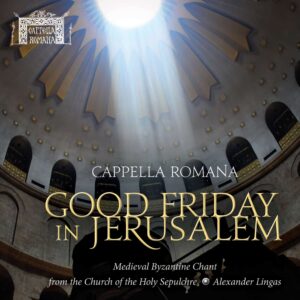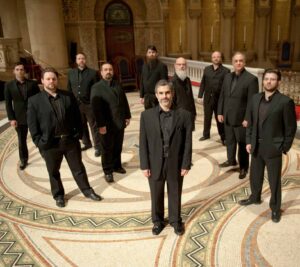 Our concert features excerpts from the “Service of the Holy Passion of our Lord Jesus Christ” as it would have been celebrated in Jerusalem during the tenth century. The ancestor of the service celebrated in the modern Byzantine rite on Holy Thursday evening, this is a stational version of the office of early morning prayer (matins or orthros, literally “dawn”) in which eleven gospel readings narrate the events of the Passion of Jesus from his Last Discourse to his disciples to his burial. The texts and rubrics of the Typikon of the Anastasis form the basis of our reconstruction, supplemented by notated musical settings for its chants transmitted in later manuscripts. Extant sources with Byzantine melodic notation date from the tenth century, with readily decipherable versions available in chantbooks copied from the late twelfth century onwards. Dr. Ioannis Arvanitis, a leading authority on medieval Byzantine musical rhythm and performance practice, edited the scores used today by Cappella Romana.
Our concert features excerpts from the “Service of the Holy Passion of our Lord Jesus Christ” as it would have been celebrated in Jerusalem during the tenth century. The ancestor of the service celebrated in the modern Byzantine rite on Holy Thursday evening, this is a stational version of the office of early morning prayer (matins or orthros, literally “dawn”) in which eleven gospel readings narrate the events of the Passion of Jesus from his Last Discourse to his disciples to his burial. The texts and rubrics of the Typikon of the Anastasis form the basis of our reconstruction, supplemented by notated musical settings for its chants transmitted in later manuscripts. Extant sources with Byzantine melodic notation date from the tenth century, with readily decipherable versions available in chantbooks copied from the late twelfth century onwards. Dr. Ioannis Arvanitis, a leading authority on medieval Byzantine musical rhythm and performance practice, edited the scores used today by Cappella Romana.
The morning or dawn (orthros) office for Holy Friday began in the middle of the night on the Mount of Olives and featured a series of processions taking worshippers to shrines at Gethsemane and other sites associated with the betrayal, trial, and crucifixion of Jesus. The first half of the service was dominated musically by an anonymous series of fifteen antiphons that accompanied and commented on events recounted in the first six gospel readings. This evening we will be singing selections from antiphons sung on and below the Mount of Olives (Antiphons 1 and 4 respectively), as well as in the final one chanted at Church of the Holy Wisdom (Hagia Sophia) built on the reputed site of the palace of Pontius Pilate (Antiphon 15). After this, the assembly processed to the atrium of the church of the Anastasis (known in medieval times as the “Center of the Earth”), where the Beatitudes and other hymns were sung before the reading of the Seventh Gospel.
 The service approaches its climax with “The Paradise in Eden,” a chant sung on the way to the Place of the Skull. The Eighth Gospel (Luke 23:32–49; omitted) was read upon arrival at Golgotha, followed by the singing of the Three-Ode Kanon by Kosmas the Melodist. Each ode consists of a model stanza (heirmos), a series of metrically and melodically identical stanzas (troparia), and a reprise of the heirmos (the katavasia). The poetic odes of kanons were originally composed to provide thematically appropriate theological commentary for the invariable sequence of nine biblical canticles or “odes” sung at Palestinian morning prayer. Three biblical odes—Isaiah 26:9–20 (Ode 5), the Hymn of the Three Youths from Daniel 3 (Ode 8), and the Magnificat and Benedictus (Ode 9=Luke 1:46–56, 68–79)—were appointed for Lenten Fridays, leading Kosmas to echo their themes in his musical meditation on the betrayal and trial of Jesus. The conclusion of the Kanon in tenth-century Jerusalem was marked by two hymns called “Exaposteilaria,” of which we sing the first, and chanting of the Ninth Gospel.
The service approaches its climax with “The Paradise in Eden,” a chant sung on the way to the Place of the Skull. The Eighth Gospel (Luke 23:32–49; omitted) was read upon arrival at Golgotha, followed by the singing of the Three-Ode Kanon by Kosmas the Melodist. Each ode consists of a model stanza (heirmos), a series of metrically and melodically identical stanzas (troparia), and a reprise of the heirmos (the katavasia). The poetic odes of kanons were originally composed to provide thematically appropriate theological commentary for the invariable sequence of nine biblical canticles or “odes” sung at Palestinian morning prayer. Three biblical odes—Isaiah 26:9–20 (Ode 5), the Hymn of the Three Youths from Daniel 3 (Ode 8), and the Magnificat and Benedictus (Ode 9=Luke 1:46–56, 68–79)—were appointed for Lenten Fridays, leading Kosmas to echo their themes in his musical meditation on the betrayal and trial of Jesus. The conclusion of the Kanon in tenth-century Jerusalem was marked by two hymns called “Exaposteilaria,” of which we sing the first, and chanting of the Ninth Gospel.
It was (and remains) customary to insert other chants and readings at certain points within a kanon. Thus the Typikon of the Anastasis places between Odes 5 and 8 the prologue and first stanza of the Kontakion on the Mary at the Cross by Romanos the Melodist. Romanos was a deacon from Beirut who settled in Constantinople during the early sixth century. There he distinguished himself as the greatest composer of the multi-stanza hymns that came to be known, after the scrolls on which they were copied, as kontakia. By the tenth century two melodic traditions had been developed for kontakia: a simple one consigned mainly to oral tradition, and a florid one transmitted in the Psaltikon, a musical collection created for the soloists of Justinian’s Great Church of Hagia Sophia. On the present concert we both the simple and elaborate melodies of the prologue to this kontakion.
In both Palestine and Constantinople the arrival of dawn was marked in daily prayer by the singing of Psalms 148–150, known collectively as Lauds. Whereas the Late Antique custom of chanting these psalms throughout with simple refrains was retained in the Constantinopolitan cathedral rite, churches associated with Jerusalem began interpolating hymns known as stichera between their concluding verses (stichoi). From the ten hymns appointed by the Typikon of the Anastasis for Lauds on Holy Friday we select seven. The first two are anonymous hymns sung to a standard model melody and assigned in modern service books to Thursday evening prayer. The remaining five stichera are through-composed works known as idiomela. A hymn in Mode 1 evoking the cosmic dimensions of Christ’s crucifixion by Theophanes Protothronos, Archbishop of Caesarea (9th c.), is followed by another written by same composer in Mode 2 commenting on his abandonment to execution. The Byzantine Emperor Leo VI the Wise (reigned 886–912) contributes a moving portrayal of the Virgin Mary lamenting at the foot of the Cross set in Mode 2. Another hymn on the rejection of Jesus by an anonymous “Byzantine” author in Mode 3 leads to the final chant of Lauds, a meditation on the Passion by an unnamed monk from the Constantinopolitan monastery of Stoudios.
We then jump over a series of prayers, readings and hymns to the Eleventh (and final) Gospel, which offers John’s account of the burial of Christ. After a few more prayers and a litany, the patriarch and archdeacon processed to a reliquary chapter behind Golgotha, from which the patriarch retrieved the cross and then carried it on his shoulders to the Chapel of the Holy Custody that was located on the other side of the atrium. At this chapel a short service evidently derived from the liturgical practices of Constantinople preceded the dismissal of the Passion Office. It consisted of dismissal of a brief reading from Zechariah (11:10–13) and several chants, the last of which was the Prokeimenon “May you, Lord, guard us,” a responsorial chant from the Psaltikon.
Pre-Order Good Friday in Jerusalem on Amazon Today!
Concert:
- In Procession to the Mount of Olives
Antiphon One in Mode Plagal 4 - At the Holy Place of Veneration (Proskynesis) at the Foot of the Mount of Olives
Antiphon 4 in Modes Plagal 1 and 1 - At the Pavement (Lithostroton) in Hagia Sophia
Antiphon 15 - At the Center of the Earth (the Atrium of the Anastasis)
Seventh Gospel – Matt. 27:33-54 - In Procession to Golgotha (the Place of the Skull)
- Processional Sticheron “The Paradise in Eden” in Mode Plagal 4
- At Golgotha
Three-Ode Kanon (Triodion) in Mode Plagal 2 — Kosmas the Melodist (8th c.)
- Ode 5
- Kontakion on Mary at the Cross — Romanos the Melodist (6th c.)
(Syllabic and Psaltikon melodies)- Ode 8
- Ode 9
- Ninth Gospel – John 19:25–37
- Exaposteilarion Automelon: “O Lord, who on that very day”
- Lauds: Psalms 148–50 (selected verses) in Mode 4
- Stichera Prosomoia in Mode 4
- “When all creation saw you crucified”
- “The eternal record of Adam”
- Sticheron Idiomelon in Mode 1 “All creation was changed” — Theophanes Protothronos (9th c.)
- Stichera Idiomelon in Mode 2
- “Impious and lawless people” — Theophanes Protothronos
- “When she saw you, O Christ” — Leo VI the Wise (866–912)
- Stichera Idiomela in Mode 3
- “Israel my firstborn son” Byzantios
- Doxastikon: “Each member of your holy flesh” Stoudites
- Stichera Prosomoia in Mode 4
- Eleventh Gospel – John 19:38–42
- At the Chapel of the Holy Custody (Hagia Phylake)
Prokeimenon “May you, Lord, guard us” in Mode Plagal 1
Good Friday in Jerusalem — Portland & Seattle
[one_half]
Seattle
Friday, 6 February 2015, 8:00pm
St. Joseph’s Parish
[/one_half][one_half_last]
Portland
Saturday, 7 February 2015, 8:00pm
Trinity Episcopal Cathedral
Sunday, 8 February 2015, 2:00pm
St. Mary’s Cathedral
[/one_half_last]

You must be logged in to post a comment.